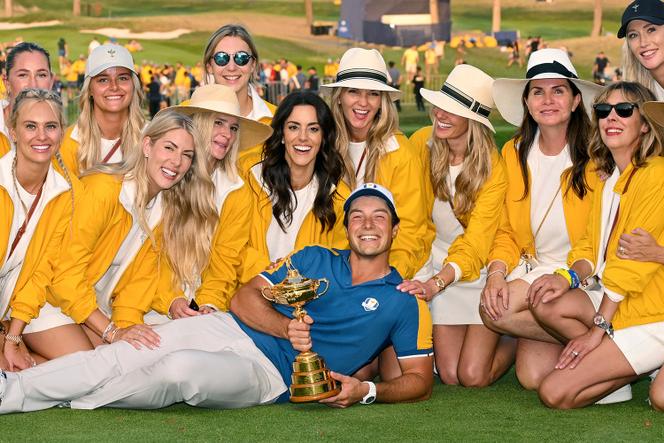


Let's start at the beginning. Every two years since 1979, a team of America's finest golfers take on their European counterparts. Held alternately in the USA and Europe, the Ryder Cup is one of the major events on the world golfing calendar, and certainly one of the most colorful. In contrast to the generally muted atmosphere of the circuit, the Ryder Cup often gives rise to outbursts, arguments and similar emotional responses, all of which are both quite cheerful and perfectly innocent, but a little embarrassing all the same, don't you think?
What can be seen here? Norwegian golfer Viktor Hovland, 26, lying on the green at Rome's Marco Simone Golf Club, cup in hand, surrounded by the wives of European team members. There are 12 of them, most of them on their knees, smiling so broadly that it looks like the teeth whitening industry is doing well among golf champions' wives. But let's just note that their jackets are the characteristic yellow of oilskins worn by sailors to ensure maximum visibility. Here, the goal may well be the same.
Many of the players' wives are wearing what look like Panama hats (although the headgear on the left of the picture is open to question). Let me remind you of a truth that is not at all self-evident, and is in fact completely counterintuitive. No, Panama hats don't come from Panama, but from a neighboring country, Ecuador. What's more, they're not just advertising materials designed to please the VIPs at Roland-Garros, but perfectly respectable hats, especially if you buy them from Montecristi or Cuenca.
Let's continue our review of the troops by focusing on the perfectly round, petroleum-colored glasses worn by the young woman in the background. These are teashades. That's what opticians called these round glasses, popularized in the 1960s by numerous celebrities, including a host of rock stars eager to effectively hide their glassy, intoxicated eyes, among them Mick Jagger, Roger Daltrey, Ozzy Osbourne and, of course, John Lennon. But I expect that the choice here is purely aesthetic.
Finally, let's turn our attention to the hero of the day, a living god or king in the midst of his court, or perhaps both. The triumphant Hovland was enjoying his moment of glory. He could even follow the slow passage of time in the best possible way: On his wrist, and behind the dazzling white ceramic, was a Royal Oak by Audemars Piguet, a horological monument inspired by the shape of a diving helmet screwed onto a wetsuit. It was designed in 1973, and in a single night, by Gérald Genta. Product placement? This photograph is all about product placement.
Translation of an original article published in French on lemonde.fr; the publisher may only be liable for the French version.
